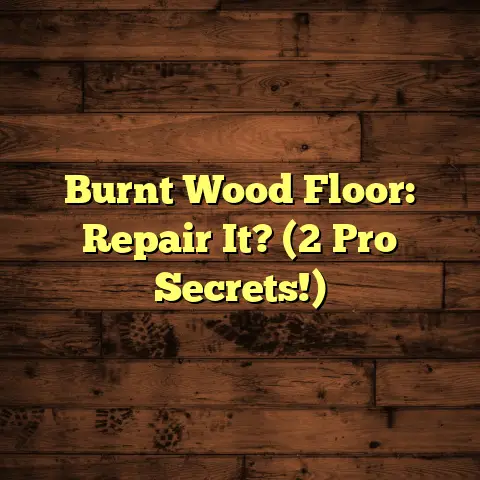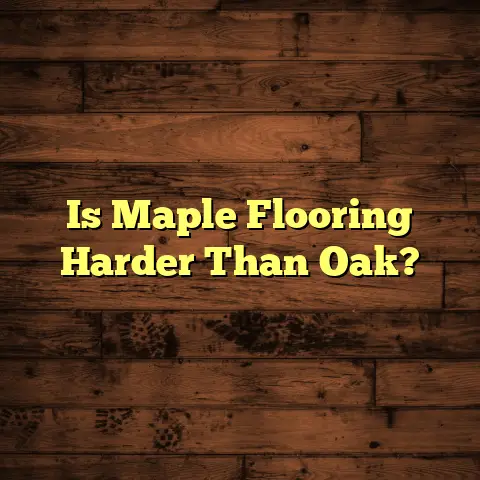Safe Rugs For Crawling Babies? (Toxic Fibers?)
As a flooring contractor, I’ve seen a huge shift in what people want for their homes, especially when little ones are involved.
It’s not just about aesthetics anymore; it’s about creating a safe, nurturing environment.
More and more parents are hyper-aware of the materials in their homes, specifically rugs, because let’s face it, that’s where our crawling babies spend a lot of time.
This concern has fueled a surge in demand for eco-friendly and non-toxic home decor.
The idea? A sustainable lifestyle where peace of mind comes standard.
So, let’s dive into this crucial topic: choosing safe rugs for our babies.
We’ll tackle those scary toxic fibers head-on!
1. Understanding the Basics of Rugs
Alright, let’s get down to the nitty-gritty of rugs. It’s more than just something soft underfoot. There is a whole world to uncover!
Types of Rugs
Think about the different rugs you see every day:
-
Area Rugs: These are your general, decorative rugs that define a space. They come in all shapes, sizes, and materials.
-
Play Mats: Designed specifically for babies and young children, these are often padded and made from easy-to-clean materials.
-
Natural Fiber Rugs: Think jute, sisal, wool, and cotton. They’re often chosen for their natural look and feel.
-
Synthetic Rugs: Made from materials like polyester, nylon, and polypropylene. They can be budget-friendly and durable.
Materials Used
The material of a rug is super important. Here’s a quick rundown:
-
Wool: A classic choice, known for its durability, warmth, and natural stain resistance.
-
Cotton: Soft and breathable, cotton rugs are often used in nurseries and kids’ rooms.
-
Polyester: A synthetic fiber that’s resistant to stains and fading. It’s often used in affordable rugs.
-
Nylon: Another synthetic option, nylon is incredibly durable and resilient.
-
Jute: A natural fiber that’s strong and adds a rustic touch to any room.
Manufacturing Processes
Here’s where things can get a little dicey.
The way a rug is made can introduce potentially harmful chemicals.
-
Dyes: Rugs are dyed to get that perfect color. Some dyes contain heavy metals or other toxins that can leach out over time.
-
Adhesives: Adhesives are used to bind the fibers together, and some contain formaldehyde, a known carcinogen.
-
Flame Retardants: Many rugs are treated with flame retardants to meet safety standards. However, some of these chemicals have been linked to health problems.
2. The Importance of Safety for
Crawling Babies
Now, why are we so concerned about all this? Well, babies are particularly vulnerable.
Developmental Milestones
Rugs play a big role in a baby’s development.
-
Crawling: Rugs provide a surface for babies to practice crawling, building strength and coordination.
-
Exploration: Babies explore their world through touch. A rug becomes a landscape for them to discover different textures and sensations.
-
Safe Play Spaces: Rugs create a designated area where babies can play safely, away from hard floors and potential hazards.
Exposure Risks
Babies are more susceptible to the harmful effects of toxins.
-
Crawling and Mouthing: Babies crawl around on rugs, picking up dust, dirt, and any chemicals that might be present. They also tend to put things in their mouths, increasing the risk of ingesting harmful substances.
-
Developing Immune Systems: Babies’ immune systems are still developing, making them more vulnerable to the effects of toxins.
-
Proximity to the Floor: Babies spend a lot of time close to the floor, where chemicals tend to settle.
3. Understanding Toxic Fibers and
Chemicals
Let’s talk specifics about what to watch out for.
Common Toxic Fibers
Some fibers are more likely to cause problems than others.
-
Synthetic Materials: While synthetics can be durable and affordable, some may contain chemicals that can off-gas over time.
-
Treated Natural Fibers: Natural fibers treated with harsh chemicals can also pose risks.
Chemicals of Concern
Here are some common culprits:
-
Formaldehyde: This chemical is often found in adhesives and finishes. It’s a known carcinogen and can cause respiratory irritation.
-
VOCs (Volatile Organic Compounds): These chemicals are released from synthetic materials and can cause headaches, nausea, and dizziness.
-
Flame Retardants: While they’re designed to protect against fire, some flame retardants have been linked to hormone disruption and developmental problems.
Health Risks
Exposure to these chemicals can have serious consequences for babies.
-
Respiratory Problems: VOCs and formaldehyde can irritate the airways and trigger asthma or allergies.
-
Skin Irritation: Contact with certain chemicals can cause rashes or other skin problems.
-
Developmental Issues: Some chemicals have been linked to developmental delays and learning disabilities.
-
Cancer: Long-term exposure to carcinogens like formaldehyde can increase the risk of cancer.
According to the EPA, children are more susceptible to the effects of air pollutants, including those from rugs, because they breathe more air per pound of body weight than adults. Source: EPA
4. Identifying Safe Rug Options
Okay, so how do we navigate all this and find safe rugs for our little ones?
Certification Standards
Look for these certifications when shopping for rugs:
-
Oeko-Tex: This certification ensures that a rug has been tested for harmful substances and is safe for human use.
-
Greenguard: This certification indicates that a rug has low chemical emissions and won’t contribute to indoor air pollution.
-
CRI Green Label Plus: This certification is specific to carpets and rugs and ensures that they meet strict standards for VOC emissions.
Natural vs. Synthetic
Generally, natural fiber rugs are considered safer than synthetic rugs.
-
Natural Fiber Rugs: Wool, cotton, jute, and sisal are all good options. Look for rugs that are undyed or dyed with natural dyes.
-
Synthetic Rugs: If you choose a synthetic rug, look for one that’s certified by Greenguard or Oeko-Tex.
Recommended Brands
Here are a few brands that specialize in safe, non-toxic rugs:
-
Lorena Canals: Known for their washable cotton rugs that are perfect for nurseries and kids’ rooms.
-
Hook & Loom: Offers a wide selection of eco-friendly rugs made from recycled materials.
-
Organic Weave: Specializes in organic wool rugs that are free from harmful chemicals.
5. Maintenance and Care for Safety
Once you’ve found a safe rug, it’s important to keep it that way.
Cleaning Practices
-
Vacuum Regularly: Vacuum your rug at least once a week to remove dust, dirt, and allergens.
-
Spot Clean with Natural Cleaners: Use a mild, natural cleaner to spot clean spills and stains. Avoid harsh chemicals like bleach or ammonia.
-
Professional Cleaning: Have your rug professionally cleaned every year or two. Be sure to choose a cleaner who uses eco-friendly products.
Regular Maintenance
-
Air Out Your Rug: Occasionally, take your rug outside to air it out. This can help to remove odors and freshen it up.
-
Rotate Your Rug: Rotate your rug every few months to distribute wear evenly.
Longevity and Replacement
-
Signs of Wear and Tear: If your rug is showing signs of wear and tear, it’s time to replace it.
-
Chemical Exposure: If you suspect that your rug has been exposed to harmful chemicals, it’s best to replace it.
As a flooring contractor, I often advise clients to replace rugs every 5-10 years, depending on the material and usage, to ensure they remain safe and hygienic, especially in homes with young children.
Conclusion
Choosing a safe rug for your crawling baby is an investment in their health and well-being.
By being informed about rug materials, manufacturing processes, and safety standards, you can create a safe and nurturing play environment for your little one.
The growing trend of eco-conscious parenting is driving the demand for safer home products, and as a result, there are more and more options available to us.
So, take your time, do your research, and choose a rug that you can feel good about.
Your baby will thank you for it!





